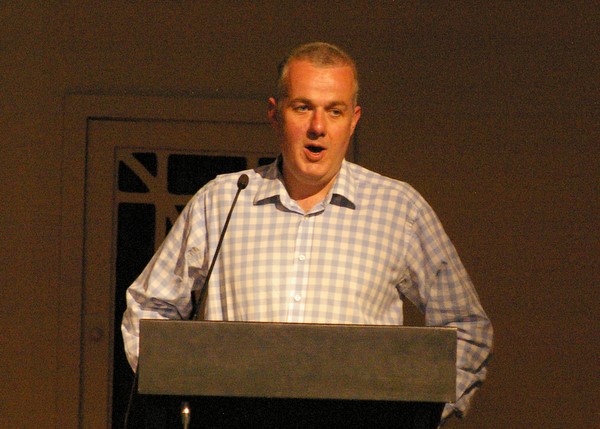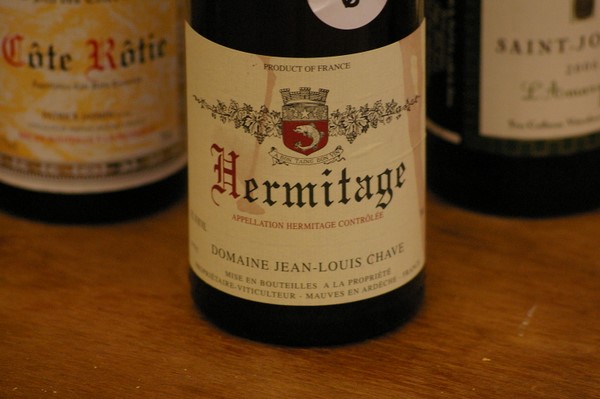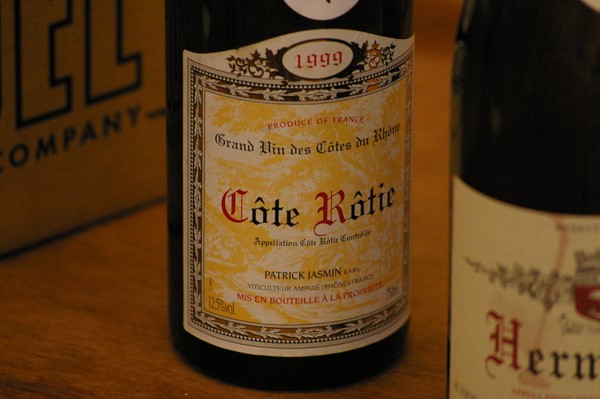|
Spotlight
on northern Rhône Syrah
A seminar/tasting with Jason Yapp

‘We
were in the right place at the right time,’ says Jason Yapp, on
how his family wine merchants became one of the top importers of Rhône
wines into the UK. At the Hawkes Bay Syrah Symposium in February
2010 he gave a thoroughly interesting talk and tasting, which would
have presented the mainly local crowd a rare chance to taste some
top Rhône Syrahs. This is my attempt to write it up, although
Jason's talk was much better than my account here!
The
Rhône is France’s second biggest river valley, stretching from
Valais to Marseille, bisecting the southeast of France. The
viticultural area of interest stretches 180 km from Vienne in the
north to Avignon in the South.

The
northern and southern Rhône are quite different regions. The
northern Rhône is a 70 km stretch from Vienne to Valence, and
it’s cooler and more temperate than the southern Rhône, which is
flatter and hotter.
The
Rhône has history. Bags of it. After all, it is known for being the
origin of Syrah, which is now one of the world's superstar
varieties. The Romans certainly knew of the quality of Rhône Syrah:
Pliny the elder referred favourably to wines from Vienne. For a long
while, in the 18th and 19th centuries, northern Rhône Syrah was
used as a booster for Bordeaux. Indeed, ‘Hermitaged’ Bordeaux
frequently fetched higher prices than the unadulterated stuff on
merchants lists.
But
it is a region that is only recently fashionable. The postwar
prosperity in France of the 1950s led to many winegrowers leaving
the vineyards. Some appellations almost became extinct. In 1965
there was only 8 hectares left of Viognier in the whole world. But
since the 1970s there has been a great renaissance of interest in
the Rhône, picking up pace in the late 1980s and early 1990s.

Côte
Rôtie
This is a small appellation of just 202 hectares. The vineyards
are steeply sloped, and there are two distinct parts of the
appellation. Côte Brune has ferruginous (with iron) mica-schist
over granite. This results in deeper, more intense and more tannic
wines. 20% of Viognier is allowed in the blend, but usually none or
up to 5% is used. Côte Blonde is sandy limestone over granite, and
results in seductive aromatic wines which don’t last as long as
those from Côte Brune.
St
Joseph
920 hecatares, but this region saw a fourfold expansion in the
1980s. The old area was expanded out of greed and this has become a
hit-or-miss appellation. Varying soils, ranging from steep granite
slopes (good) and poor land that shouldn’t be planted. These are
the lightest and fruitiest wines of the northern Rhône.
Hermitage
The jewel in the crown of the northern Rhône, it’s a big
saddle-shaped block of granite. The soils vary: there are 19
different Lieux dits. Les Bessards is the biggest. Overall, just 140
hectares of vineyard. It’s a steep southerly slope with mainly
granitic soils, but the key is to blend across the different soils.
You can’t really have a great Hermitage without Bessards in it;
other bits include Le Meal (limestone/quartz) and l’Hermite
(ferruginous, iron-rich).
Crozes
Hermitage
The largest appellation in the region with 1280 hectares, and
it’s the flatter area at the top of and behind the hill of
Hermitage. Varied topography and soils.
Cornas
A small appellation of 90 hectares, with the vines in a
south-facing ampitheatre. It now makes some of the finest Syrahs in
the Northern Rhône, although some still consider Cornas to be
'rustic' (quite wrongly, in my opinion).
THE
WINES
Alain
Graillot Crozes Hermitage 2007
In 1985 Alain Graillot gave up a career in the agrochemical
industry and rented some vines. Now he owns 17.3 hectares of Syrah
and 2.6 ha of Marsanne and Rousanne, and is making some of the Rhônes
most interesting wines. He ferments with stems, and uses second-hand
barrels from Dujac. This wine has a fresh, peppery, meaty, spicy
nose with a lovely savoury dimension. The palate is concentrated but
fresh with lovely savoury, pure raspberry fruit. Juicy and bright
with mineral complexity. Firm, edgy and savoury with high acidity,
but just beautiful. 93/100 (Interestingly, Robert Parker gave this
83–85/100)
Yves
Cuilleron Saint Joseph L’Amarybelle’ 2006
Yves Cuilleron has holdings in St Joseph, Condrieu and Côte Rôtie,
and he’s one of the brightest talents of the region. This wine has
a beautifully focused, aromatic, floral, meaty, spicy nose with
lovely freshness and also some pepperiness. The palate has focused,
juicy, vibrant cherry and raspberry fruit with a strong savoury
dimension. Pure, lively and expressive. 94/100
E
Guigal Château d’Ampuis Côte Rôtie 2005
93% Syrah, 7% Viognier. Marcel Guigal produces 40% of all Côte
Rôtie by volume; he joined the family firm in 1961 aged just 18.
This wine was first made in 1995 when Guigal bought Château
d’Ampuis, and has grapes from seven different lieux dits. It’s
aged in 100% new oak, in which it spends just over 3 years. Spicy,
focused and fresh with some elegance and fresh acidity. Quite
Burgundian with savoury spicy tannic structure well integrated into
the wine. Subtly meaty and peppery, and not as edgy as northern Rhône
Syrah can be. Polished with well integrated oak. 92/100
Patrick
Jasmin Côte Rôtie 1999
Patrick took over from his father in 1999, and farms 5.3
hectares in 8 different climates. Sweet, pure liqueur-like edge to
the raspberry and cherry fruit. Very seductive and elegant with nice
freshness. The palate shows elegant bright fruit and nice meaty,
spicy overtones. There’s real focus and poise here: it’s a
Burgundian expression of Syrah. Peaking now. 94/100
Clape
Cornas 2004
Auguste, Pierre and Olivier Clape farm 5.4 hectares in Cornas,
and the wines undergo a short fermentation with stems. This has a
beautifully focused sweet dark fruits nose. It’s concentrated and
intense with blackberry and raspberry fruit bolstered by good
acidity and some lovely spicy tannins. Rich but with lovely edges,
too. 94/100
JL
Chave Hermitage 2001
The Chaves have 13.9 hectares of Hermitage (9.3 Syrah, 4.6
Marsanne and Roussanne), and they could justifiably claim to be the
top domaine in the northern Rhône. This is beautifully fresh and
bright with lovely acidity, and firm but not aggressive tannins.
There’s some meaty, spicy complexity. It’s assertive and savoury
with very little fleshiness or richness, but it’s a proper, proper
wine. 95/100
Published
12/10
Wines tasted 02/10
Find these wines with wine-searcher.com
Back
to top
|

